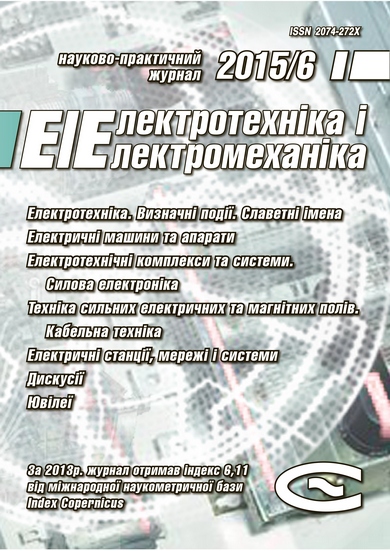UNIFIED MODELS OF ELEMENTS OF POWER SUPPLY SYSTEMS BASED ON EQUATIONS IN PHASE COORDINATES
DOI:
https://doi.org/10.20998/2074-272X.2015.6.10Keywords:
power system, transients, mathematical model, electrical machines, synchronous generator, induction motor, phase coordinatesAbstract
Purpose. The models of electrical machines in the phase coordinates, the universal algorithm for the simulation of separate elements in a d-q coordinates system and in a phase-coordinates system are proposed. Methodology. Computer methods of investigation of transients in electrical systems are based on a compilation of systems of differential equations and their numerical integration solution methods. To solve differential equations an implicit method of numerical integration was chosen. Because it provides to complete structural simulation possibility: firstly developing models of separate elements and then forming a model of the complex system. For the mathematical simulation of electromagnetic transients in the elements of the electrical systems has been accepted the implicit Euler-Cauchy method, because it provides a higher precision and stability of the computing processes. Results. In developing the model elements identified two groups of elements: - Static elements and electrical machines in the d-q coordinates; - Rotating electrical machines in phase coordinates. As an example, the paper provides a model of synchronous and asynchronous electric machines in the d-q coordinates system and the phase coordinate system. The generalization algorithm and the unified notation form of equations of elements of an electrical system are obtained. It provides the possibility of using structural methods to develop a mathematical model of power systems under transient conditions. Practical value. In addition, the using of a computer model allows to implement multivariant calculations for research and study of factors affecting the quantitative characteristics of the transients.References
Vazhnov A.I. Perekhodnye protsessy v mashinakh peremennogo toka [Transients in an AC machines]. Leningrad, Energiia Publ., 1980. 256 p. (Rus).
Erokhin A.M., Korotkov B.A., Popkov E.N. The equations and equivalent circuit of the multiwinding machines in phase coordinates. Trudyi LPI – Works of the Leningrad Polytechnic Institute, 1986, no.421, pp. 68-76. (Rus).
Chernovets A.K., Semyonov K.N., Fedotov A.M. Mathematical modeling of own needs of power plants in calculations of automatic starting of motors. Issledovaniya elektromagnitnyih protsessov v energeticheskih ustanovkah – Research of electromagnetic processes in power plants, 1988, no.1, pp. 52-57. (Rus).
Golodnov Yu.M. Samozapusk elektrodvigateley [Automatic starting of motors]. Moscow, Energoatomizdat Publ., 1985. (Rus).
Strakhov S.P. Perekhodnye protsessy v elektricheskikh tsepiakh, soderzhashchikh mashiny peremennogo toka [Transients in electrical circuits containing AC machines]. Moscow, Gosenergoizdat Publ., 1960. (Rus).
Vepryk Yu.N. Base mathematical model of electromagnetic transient processes in electric systems with unsymmetry. Skhidno-Yevropeiskyi zhurnal peredovykh tekhnolohii – Eastern-European Journal of Enterprise Technologies, 2010, vol.2, no.7(44), pp. 37-42. (Rus).
Vepryk Yu.N., Lebedka S.N., Vepryk V.Yu. Mathematical modelling of transient processes in electric networks with an insulated neutral in phase coordinates. Elektrotekhnika i elektromekhanika – Electrical engineering & electromechanics, 2005, no.3, pp. 74-77. (Rus).
Downloads
Published
How to Cite
Issue
Section
License
Copyright (c) 2015 Yu. M. Vepryk, O. A. Nebera

This work is licensed under a Creative Commons Attribution-NonCommercial 4.0 International License.
Authors who publish with this journal agree to the following terms:
1. Authors retain copyright and grant the journal right of first publication with the work simultaneously licensed under a Creative Commons Attribution License that allows others to share the work with an acknowledgement of the work's authorship and initial publication in this journal.
2. Authors are able to enter into separate, additional contractual arrangements for the non-exclusive distribution of the journal's published version of the work (e.g., post it to an institutional repository or publish it in a book), with an acknowledgement of its initial publication in this journal.
3. Authors are permitted and encouraged to post their work online (e.g., in institutional repositories or on their website) prior to and during the submission process, as it can lead to productive exchanges, as well as earlier and greater citation of published work.





